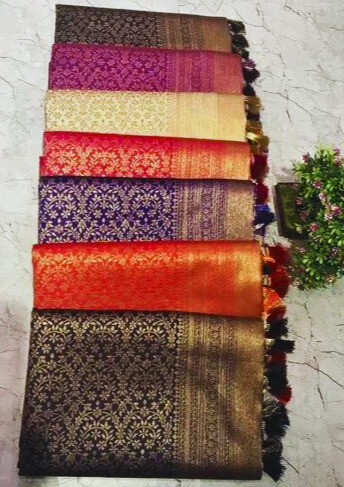Skin Tones and Fashion
“Explore the endless possibilities of fashion by incorporating colors that complement your skin tone. Whether you have warm, cool, or neutral undertones, there are countless hues and shades waiting to enhance your natural beauty. Embrace the journey of self-discovery through fashion, and let your style reflect the vibrant and diverse person you are.”

Introduction
Fashion is not just about the clothes we wear; it’s also about how those clothes complement our natural features. One crucial aspect of fashion that often goes unnoticed is how skin tone influences our style choices. Understanding the relationship between skin tones and fashion can help individuals make more informed decisions when it comes to selecting clothing, accessories, and makeup.
Understanding Different Skin Tones
Types of Skin Undertones
Skin undertones are the subtle colors beneath the skin’s surface that influence how colors—whether in clothing, makeup, or accessories—appear on an individual. There are three primary undertones and a fourth unique category:
1. Warm Undertones
Warm undertones have a golden, yellow, or peachy hue beneath the skin. People with warm undertones tend to have skin that tans easily rather than burning.
Common Indicators:
- Greenish veins on the wrist
- Gold jewelry looks more flattering than silver
- Peach, golden, or yellow hues in the skin
- Skin tends to tan rather than burn
Best Colors for Clothing:
- Earthy tones: mustard yellow, terracotta, warm reds, olive green, and rich browns
- Warm jewel tones: golden hues, warm oranges, and sunset shades
- Off-white or cream instead of stark white
Celebrities with Warm Undertones:
- Beyoncé
- Priyanka Chopra
- Gigi Hadid
2. Cool Undertones
Cool undertones have a pink, blue, or red hue beneath the skin. People with this undertone often have fair or deep skin that may burn easily in the sun.
Common Indicators:
- Bluish or purplish veins on the wrist
- Silver jewelry looks more flattering than gold
- A pink or reddish undertone in the skin
- Skin burns more easily than it tans
Best Colors for Clothing:
- Cool jewel tones: sapphire blue, emerald green, royal purple
- Icy shades: baby blue, lavender, icy pink
- True white or cool gray instead of warm beige
Celebrities with Cool Undertones:
- Anne Hathaway
- Lupita Nyong’o
- Taylor Swift
3. Neutral Undertones
Neutral undertones have a balance of warm and cool hues, often resulting in a skin tone that works well with a wide range of colors.
Common Indicators:
- Veins appear as a mix of blue and green
- Both silver and gold jewelry are equally flattering
- Skin has a mix of pink and yellow undertones
- Can tan and burn equally
Best Colors for Clothing:
- Universal colors: teal, blush pink, soft red, and classic navy
- Neutral shades: taupe, beige, charcoal, and soft white
- Pastels and jewel tones (can experiment with both cool and warm shades)
Celebrities with Neutral Undertones:
- Jennifer Aniston
- Zendaya
- Natalie Portman
4. Olive Undertones (A Subtype of Neutral Undertone)
Olive undertones are a blend of neutral, warm, and greenish hues. This undertone is unique because it can lean toward warm or cool depending on the lighting and surrounding colors.
Common Indicators:
- Veins may look slightly green or a mix of blue and green
- A subtle, almost greenish tint to the skin
- Can wear many shades but might struggle with pastels or overly warm tones
- Tans very easily with a golden glow
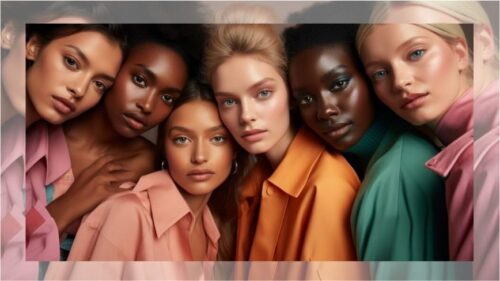
Best Colors for Clothing:
- Rich, muted shades: deep burgundy, forest green, burnt orange
- Jewel tones: sapphire, emerald, and deep purples
- Avoid overly bright neons or cool pastels
Celebrities with Olive Undertones:
- Penélope Cruz
- Kim Kardashian
- Adriana Lima
How to Identify Your Undertone?
- Vein Test: Look at the veins on your wrist under natural light:
- Green veins → Warm undertone
- Blue or purple veins → Cool undertone
- A mix of both → Neutral undertone
- Jewelry Test:
- Gold jewelry looks better → Warm undertone
- Silver jewelry looks better → Cool undertone
- Both look equally good → Neutral undertone
- White Paper Test: Hold a white sheet next to your face:
- If your skin looks yellowish → Warm undertone
- If your skin looks rosy or bluish → Cool undertone
- If your skin looks balanced → Neutral undertone
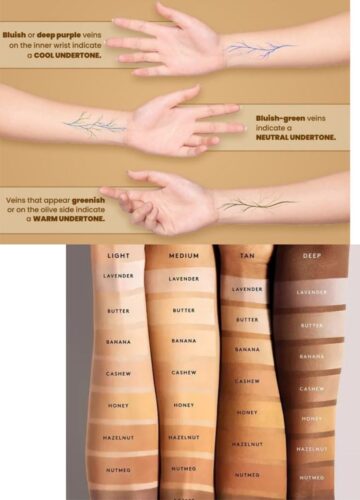
Why Undertones Matter in Fashion?
Understanding your undertone helps you:
✔️ Choose clothing colors that enhance your natural glow
✔️ Select the right makeup shades for a seamless, natural look
✔️ Pick jewelry that complements your complexion
✔️ Create a wardrobe that flatters your unique beauty
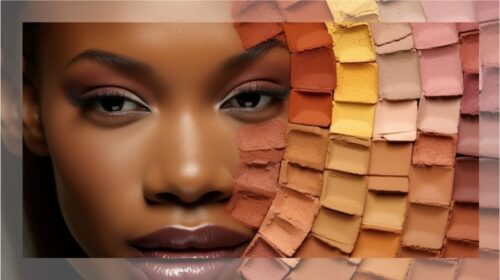
How to Choose Clothes According to Your Skin Undertone
Wearing the right colors can enhance your natural beauty, make your skin glow, and give you a polished look. Here’s a detailed guide to selecting clothes based on your warm, cool, neutral, or olive undertones.
1. Warm Undertones
People with warm undertones have golden, yellow, or peachy hues in their skin. They glow in earthy and warm shades.
✔️ Best Clothing Colors for Warm Undertones
✅ Earthy and warm shades: Mustard yellow, terracotta, burnt orange, brick red
✅ Warm jewel tones: Golden brown, warm olive, deep coral, bronze
✅ Neutrals: Beige, camel, warm white (off-white), cream, chocolate brown
✅ Metallics: Gold over silver
❌ Colors to Avoid
🚫 Cool pastels like icy blue, cool gray, and pale pink can make warm skin look dull
🚫 Neon shades can overpower your golden glow
Best Outfit Combinations for Warm Undertones:
- Casual: A mustard yellow top with beige trousers
- Formal: A deep coral dress with gold accessories
- Winter wear: A camel coat with warm brown boots
🔹 Example Celebrities with Warm Undertones: Beyoncé, Priyanka Chopra, Gigi Hadid
2. Cool Undertones
Cool undertones have pink, blue, or red hues in their skin. They look best in jewel and icy tones.
✔️ Best Clothing Colors for Cool Undertones
✅ Cool jewel tones: Sapphire blue, emerald green, deep purple, ruby red
✅ Icy shades: Icy pink, baby blue, soft lavender, cool mint green
✅ Neutrals: Charcoal gray, crisp white, navy blue, true black
✅ Metallics: Silver over gold
❌ Colors to Avoid
🚫 Warm earth tones like mustard, orange, and brown can make cool skin look sallow
🚫 Overly warm shades like bright yellow or copper may clash with your complexion
Best Outfit Combinations for Cool Undertones:
- Casual: A navy blue sweater with crisp white jeans
- Formal: A royal blue gown with silver jewelry
- Winter wear: A cool gray coat with blue accessories
🔹 Example Celebrities with Cool Undertones: Anne Hathaway, Lupita Nyong’o, Taylor Swift
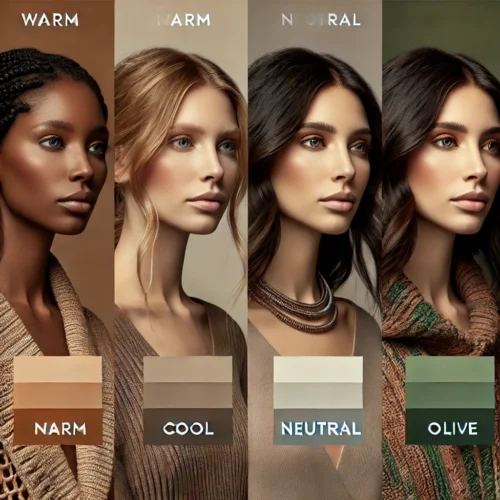
3. Neutral Undertones
Neutral undertones have a mix of warm and cool hues, allowing them to wear a variety of colors.
✔️ Best Clothing Colors for Neutral Undertones
✅ Universal colors: Teal, blush pink, classic red, deep plum
✅ Balanced shades: Dusty rose, soft taupe, medium gray, rich navy
✅ Neutrals: Soft white, beige, chocolate brown, charcoal
✅ Metallics: Both gold and silver work equally well
❌ Colors to Avoid
🚫 Some extremely warm or cool tones might wash you out (like neon yellow or icy blue)
Best Outfit Combinations for Neutral Undertones:
- Casual: A dusty rose blouse with taupe trousers
- Formal: A deep plum dress with both gold and silver accessories
- Winter wear: A beige trench coat with neutral scarves
🔹 Example Celebrities with Neutral Undertones: Zendaya, Jennifer Aniston, Natalie Portman
4. Olive Undertones (Subtype of Neutral)
Olive undertones have a mix of neutral, warm, and green hues. Some colors can make their skin look grayish, so balance is key.
✔️ Best Clothing Colors for Olive Undertones
✅ Muted warm tones: Deep burgundy, forest green, burnt orange, rust red
✅ Jewel tones: Sapphire, emerald, deep purple, warm plum
✅ Neutrals: Warm taupe, rich navy, dark olive, charcoal gray
✅ Metallics: Bronze, rose gold, and antique gold
❌ Colors to Avoid
🚫 Very bright neon shades may clash with olive skin
🚫 Pastel colors like baby blue or soft pink can make the skin look dull
Best Outfit Combinations for Olive Undertones:
- Casual: A burnt orange dress with gold accessories
- Formal: A deep emerald gown with bronze heels
- Winter wear: A dark olive coat with rich brown boots
Olive Undertone Highlights:
- Olive undertones can sometimes appear slightly greenish or ashy.
- They work best with earthy, muted, and rich warm tones (like olive green, rust, and bronze).
- Avoid cool pastels and overly blue-toned shades as they may make the skin appear dull.
- Olive skin often tans well and rarely burns.
🔹 Example Celebrities with Olive Undertones: Penélope Cruz, Kim Kardashian, Adriana Lima
Quick Color Cheat Sheet Based on skin colors and Undertones
Olive undertone is a unique undertone that falls between warm and neutral but has a slight greenish or ashy hue. It is common in medium to deep skin tones and can sometimes make finding flattering colors a bit tricky.
Here’s an updated table including Olive Undertone:
| Skin Tone | Undertone | Recommended Colors | Avoid These Colors |
|---|---|---|---|
| Fair | Warm Undertone | Peach, coral, golden yellow, warm beige, burnt orange, warm reds. | Cool blues, icy shades, deep purples. |
| Fair | Cool Undertone | Soft pastels like baby pink, lavender, icy blue; jewel tones like emerald, sapphire, amethyst; cool grays, cool-toned reds. | Warm earthy tones like mustard, olive, rust; overly bright yellows, oranges. |
| Fair | Neutral Undertone | Balanced shades like rose pink, soft mauve, teal, light brown; versatile tones. | Overly warm or overly cool shades that may wash out the complexion. |
| Medium | Warm Undertone | Warm reds, bronzy tones, golden yellows, rich greens like olive and emerald. | Cool grays, icy blues, pastel shades. |
| Medium | Cool Undertone | Cool berries like plum, raspberry; jewel tones; deep navy; icy pinks. | Warm oranges, bright yellows, certain browns. |
| Medium | Neutral Undertone | Warm neutrals like taupe, mocha; soft reds; balanced blues; mauve. | Extreme warm tones like neon orange or cool tones like frosty blues. |
| Medium | Olive Undertone | Earthy tones like olive, moss green, warm taupes, bronze, rich warm reds, deep teal. | Colors with strong blue or purple undertones, ashy pastels, neon shades. |
| Deep | Warm Undertone | Warm golds, copper, burnt orange, deep reds, rich greens. | Ashy blues, icy whites, cool pastels. |
| Deep | Cool Undertone | Deep purples, sapphire blue, cool plums, rich magentas. | Warm oranges, neon yellows, mustard shades. |
| Deep | Neutral Undertone | Deep rose, balanced browns, rich burgundy, teal. | Muted colors that don’t provide sufficient contrast. |
| Deep | Olive Undertone | Deep earthy tones like forest green, dark browns, rust, golden bronze, warm terracotta, mustard. | Frosty or cool-toned colors like icy pinks, cool grays, or pale blues. |
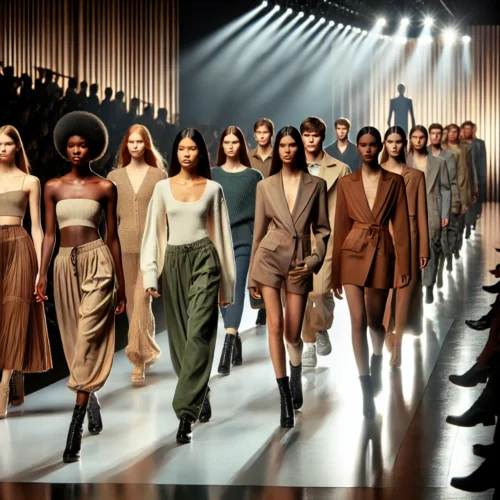
Final Tips for Choosing Clothes by Undertone
✔️ If unsure, try the white vs. off-white test: If pure white suits you better, you have cool undertones. If off-white/cream looks better, you have warm undertones.
✔️ Stick to your best color palette but experiment! Some neutrals and jewel tones work for everyone.
✔️ Use accessories to balance colors: If you wear a color that doesn’t match your undertone, add accessories in your best shades to offset the effect.
Leading fashion stylists, including Rachel Zoe, Law Roach, and Zerina Akers, emphasize the importance of color coordination based on skin undertones to enhance overall styling.

“Did you manage to identify your skin tone season using the chart provided above? When it comes to wardrobe palettes, there are four recognized color seasons. Once you’ve figured out your season, you can delve deeper into the subcategories of each season to get a clearer picture of the colors that will complement your skin, hair, and eyes. Each season is associated with a range of hues that will enhance your natural tones!“
Top Fashion Brands Catering to Skin Tone Diversity
Some fashion brands are taking inclusivity to the next level by designing collections that complement all skin tones. Notable brands include:
- Fenty by Rihanna – Known for its inclusive approach in both beauty and fashion.
- Dior – Adapts color palettes in seasonal collections to cater to diverse skin shades.
- Balmain – Frequently showcases multicultural models in color-appropriate ensembles.
💡 Explore more about inclusive fashion brands.
Recent Fashion Events Highlighting Skin Tone-Based Styling
Major fashion events are now actively celebrating diversity in color choices. Some of the latest examples include:
- Paris Fashion Week 2024 – Brands like Louis Vuitton and Valentino showcased collections with models of diverse skin tones, ensuring outfit colors were curated accordingly.
- Met Gala 2024 – Celebrity stylists tailored outfits based on skin tone harmonization, featuring monochrome, contrast, and complementary palettes.
- New York Fashion Week (NYFW) 2024 – Introduced new collections embracing “Color Theory” in styling to flatter different skin tones.
📅 Stay updated on upcoming events at Fashion Week Online.
📌 Stay ahead in fashion trends with updates from WWD and Vogue.
Cultural Influences on Color Choices
Color choices aren’t just about fashion—they’re a full-blown cultural adventure! In China, red means luck and joy (weddings love it!), but show up in red at a Western funeral, and people might think you’re crashing the wrong party. Meanwhile, white in the West screams “wedding bells,” but in India, it whispers “mourning mode activated.” Yellow can mean happiness, caution, or “banana vibes” depending on where you are. Basically, colors have personalities—and serious mood swings across borders! So before you design that “global” outfit, remember: one culture’s celebration shade might be another’s fashion faux pas. Color carefully, or face the shade!
Tips for Enhancing Personal Style
When it comes to fashion, personal style should always take precedence. Experimenting with different colors and styles allows individuals to express their unique personalities and preferences.
Experiment with Patterns and Textures:
In addition to colors, consider incorporating patterns and textures into your wardrobe to add depth and interest to your outfits. Experiment with floral prints, geometric patterns, and textured fabrics like lace or velvet to elevate your style.
Make your color Palette:
Once you are fine tuned about skin tone make a color palette of own. The palette includes jewelry, fabrics, makeup and other accessories in their shades and in hues.
Accessorize Thoughtfully:
Accessories can play a crucial role in tying together an outfit and enhancing your overall look. When choosing accessories such as jewelry, scarves, or handbags, opt for pieces that complement your skin tone and the colors of your clothing. For example, gold jewelry tends to complement warm undertones, while silver jewelry complements cool undertones.
Consider the Occasion:
The occasion should also influence your color choices. For formal events, opt for classic and sophisticated colors like black, navy, or charcoal gray. For casual outings, feel free to experiment with bolder and more vibrant hues to reflect your personal style.
Seek Inspiration:
Don’t hesitate to seek inspiration from fashion magazines, social media influencers, or celebrity style icons. Pay attention to how they incorporate colors into their outfits and adapt their looks to suit your own preferences and skin tone.
Be Confident:
Ultimately, confidence is the key to pulling off any look. Wear colors that make you feel good about yourself and project confidence in your style choices. When you feel comfortable and confident in what you’re wearing, it will show in your demeanor and how others perceive you.
Conclusion
Understanding how skin tones interact with fashion choices is essential for creating stylish and flattering looks. By embracing the diversity of skin tones and incorporating them into fashion trends, individuals can enhance their personal style and celebrate their unique beauty.
FAQs
Q. How can I determine my skin undertone?
Understanding your skin undertone is essential for choosing colors that complement your complexion. You can determine your undertone by observing the color of your veins on your wrist. Blue or purple veins indicate cool undertones, while green veins suggest warm undertones.
Q. What if I have a neutral undertone?
If you have a neutral undertone, you may find that you can wear a wide range of colors with ease. Experiment with both warm and cool tones to see what works best for you and enhances your natural features.
Q. Are there specific colors I should avoid based on my skin tone?
While there are no strict rules, certain colors may not complement your skin tone as well as others. For example, individuals with cool undertones may want to avoid colors with too much yellow or orange, while those with warm undertones may steer clear of shades that are too cool or icy.
Q. How can I incorporate my skin tone into my makeup routine?
Consider choosing makeup shades that complement your skin tone and undertone. For example, warm-toned individuals may opt for earthy eyeshadows and peachy blushes, while cool-toned individuals may prefer cool-toned lipsticks and rosy blushes.
Q. What if I’m still unsure about which colors suit me best?
If you’re unsure about which colors flatter your skin tone, consider seeking advice from a professional stylist or makeup artist. They can provide personalized recommendations based on your unique features and preferences.

Feel free to reach out if you have any further questions or need additional assistance!

